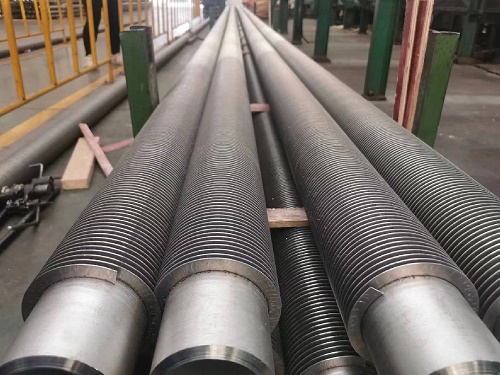What is fin pipe heat transfer principle?
2023-11-01Leave a message
Fin Pipe Heat Transfer Principle
In many cases, in a heat exchanger composed of regular circular tubes, the heat transfer coefficients for the fluid outside the tube and the fluid inside the tube are not the same. The heat transfer coefficient refers to the amount of heat transferred per unit area for a unit temperature difference (temperature difference between the fluid and the wall). It represents the heat transfer capacity between the fluid and the wall. For example:
- The heat transfer coefficient when water condenses on a surface is: 10,000 - 20,000 W/(m²·°C)
- The heat transfer coefficient when water boils on a surface is: 5,000 - 10,000 W/(m²·°C)
- The heat transfer coefficient when water flows over a surface is approximately: 2,000 - 10,000 W/(m²·°C)
- The heat transfer coefficient when air or smoke flows over a surface is: 20 - 80 W/(m²·°C)
- The heat transfer coefficient during natural air convection is only: 5 - 10 W/(m²·°C)
It is evident that there is a significant difference in the heat transfer capacity between the fluid and the wall.
Now, consider an actual heat transfer scenario: Inside a circular tube, there is flowing water with a heat transfer coefficient of 5,000 (---), while outside the tube, there is flowing smoke with a heat transfer coefficient of only 50 (---), a difference of 100 times. When heat is transferred from the inside of the tube to the outside, or from the outside to the inside, where does the "bottleneck" or "maximum resistance" in the heat transfer process occur? It is, of course, on the side of the smoke, as the heat transfer coefficient on the smoke side is the lowest, limiting the increase in heat transfer.
Here, lets take an example of a series of resistors: In a series circuit consisting of multiple resistors, if one resistor has a much larger resistance than the others, that resistor will be the "bottleneck" for the current, and only by reducing the maximum resistance can the current passing through the series circuit be effectively increased. The same principle applies to the heat transfer process mentioned above.
How can we increase the heat transfer rate in circular tubes?
One of the most effective methods is to use extended surfaces on the outside of the tubes, which is achieved by making finned pipes. Assuming that the actual heat transfer surface area of the finned pipes is several times that of the original smooth tubes, even though the heat transfer coefficient of the smoke remains low, the heat transfer effect reflected on the outer surface of the smooth tubes will significantly increase, thereby enhancing the entire heat transfer process. In situations with a constant total heat transfer rate, this reduces the metal consumption of the equipment and improves its economic efficiency.


